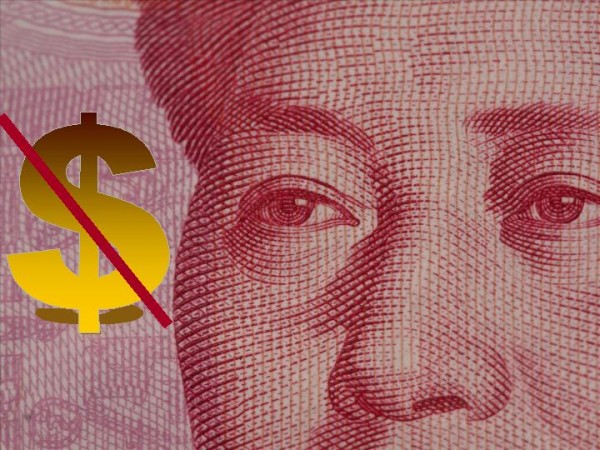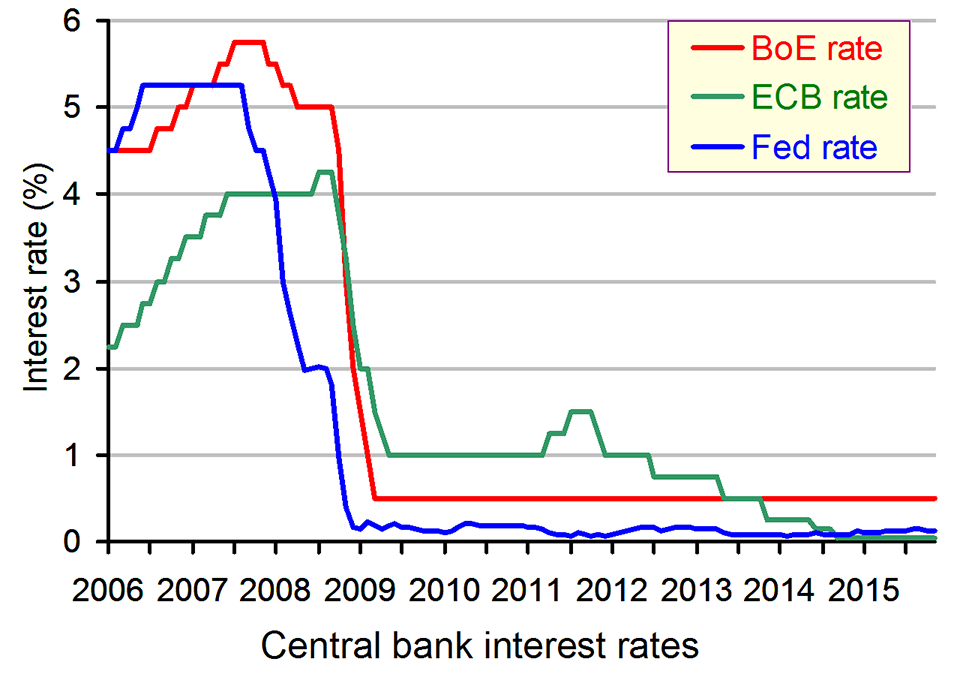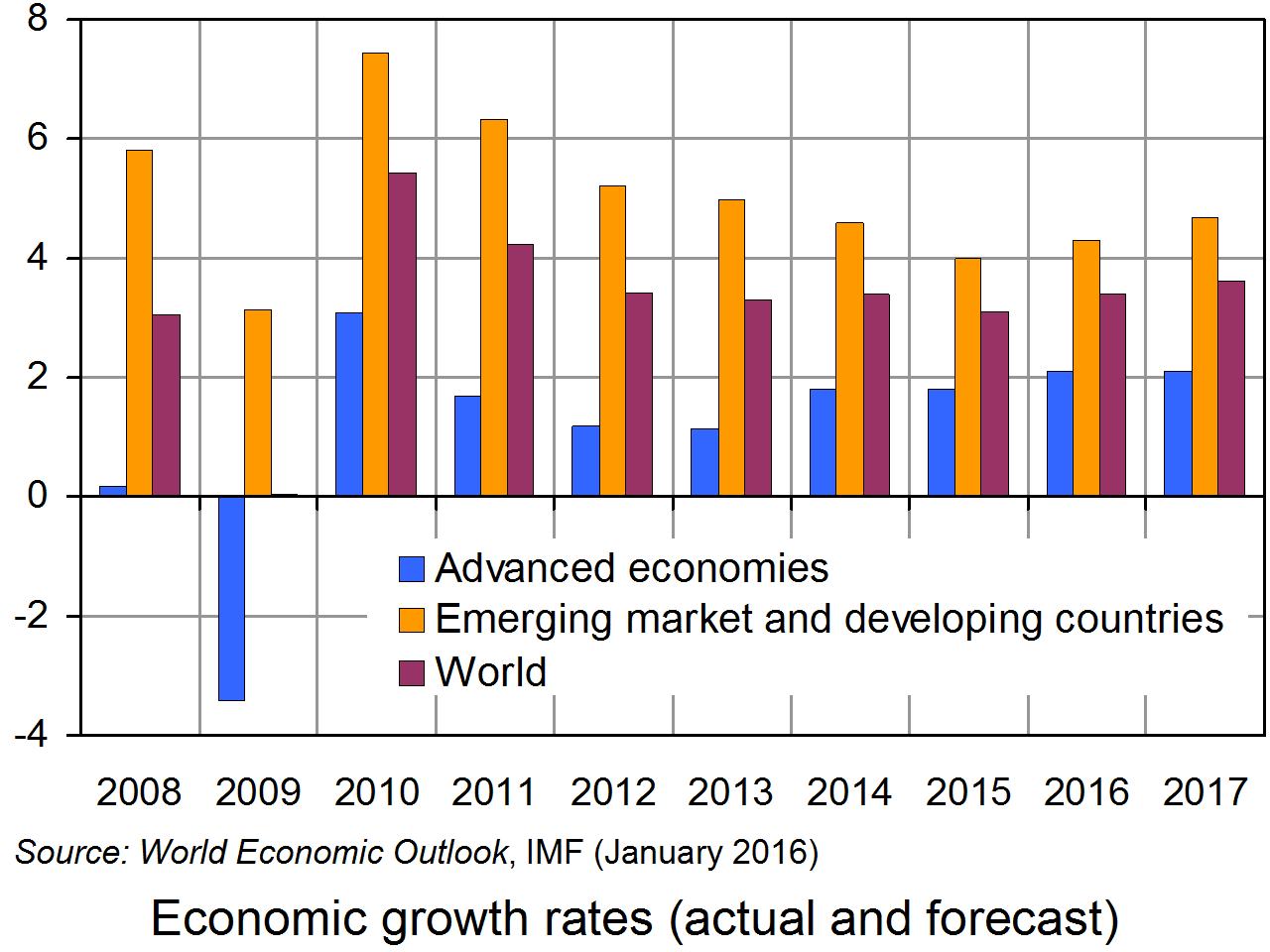 There is a lot of pessimism around about the state of the global economy and the prospects for more sustained growth. Stock markets have been turbulent; oil and other commodity prices have fallen; inflation has been below central bank targets in most countries; and growth has declined in many countries, most worryingly in China.
There is a lot of pessimism around about the state of the global economy and the prospects for more sustained growth. Stock markets have been turbulent; oil and other commodity prices have fallen; inflation has been below central bank targets in most countries; and growth has declined in many countries, most worryingly in China.
The latest worry, expressed by finance ministers at the G20 conference in Shanghai, is that UK exit from the EU could have a negative impact on economic growth, not just for the UK, but for the global economy generally.
But is this pessimism justified? In an interesting article in the Independent, Hamish McRae argues that there are five signs that the world economy is not doomed yet! These are:
|
|
| • |
There are more monetary and fiscal measures that can still be taken to boost aggregate demand. |
| • |
Despite some slowing of economic growth, there is no sign of a global recession in the offing. |
|
|
| • |
US and UK growth are relatively buoyant, with consumer demand ‘driving the economy forward’. |
| • |
Deflation worries are too great, especially when lower prices are caused by lower commodity prices. These lower costs should act to stimulate demand as consumers have more real purchasing power. |
| • |
Inflation may start to edge upwards over the coming months and this will help to increase confidence as it will be taken as a sign that demand is recovering. |
So, according to McRae, there are five things we should look for to check on whether the global economy is recovering. He itemises these at the end of the article. But are these the only things we should look for?
Five signs that the world economy is not doomed yet Independent, Hamish McRae (27/2/15)
Questions
- What reasons are there to think that the world will grow more strongly in 2016 than in 2015?
- What reasons are there to think that the world will grow less strongly in 2016 than in 2015?
- Distinguish between leading and lagging indicators of economic growth.
- Do you agree with McRae’s choice of five indicators of whether the world economy is likely to grow more strongly?
- What indicators would you add to his list?
- Give some examples of ‘economic shocks’ that could upset predictions of economic growth rates. Explain their effect.
 In the UK, petrol prices have fallen significantly over the past couple of years and currently stand in some places at below £1 per litre. For UK residents, this price is seen as being cheap, but if we compare it to prices in Venezuela, we get quite a different picture. Prices are increasing here for the first time in 20 years from $0.01 per litre to $0.60 per litre – around 40 pence, while lower grade petrol increases to $0.10 per litre.
In the UK, petrol prices have fallen significantly over the past couple of years and currently stand in some places at below £1 per litre. For UK residents, this price is seen as being cheap, but if we compare it to prices in Venezuela, we get quite a different picture. Prices are increasing here for the first time in 20 years from $0.01 per litre to $0.60 per litre – around 40 pence, while lower grade petrol increases to $0.10 per litre.
Venezuela has oil fields in abundance, but has not used this natural resource to its full potential to bolster the struggling economy. The price of petrol has been heavily subsidised for decades and the removal of this subsidy is expected to save around $800 million per year.
 This will be important for the economy, given its poor economic growth, high inflation and shortages of some basic products. Venezuela relies on oil as the main component of its export revenues and so it has been hit very badly, by such low oil prices. The money from this reduced subsidy will be used to help social programmes across the country, which over time should help the economy.
This will be important for the economy, given its poor economic growth, high inflation and shortages of some basic products. Venezuela relies on oil as the main component of its export revenues and so it has been hit very badly, by such low oil prices. The money from this reduced subsidy will be used to help social programmes across the country, which over time should help the economy.
In addition to this reduced subsidy on petrol prices, Venezuela’s President has also taken steps to devalue the exchange rate. This will help to boost the economy’s competitiveness and so is another policy being implemented to help the economy. However, some analysts have said that these changes don’t go far enough, calling them ‘small steps’, ‘nowhere near what is required’ and ‘late and insufficient’. The following articles consider the Venezuelan crisis and policies.
Venezuela raises petrol price for first time in 20 years BBC News (18/02/16)
Venezuela president raises fuel price by 6,000% and devalues bolivar to tackle crisis The Guardian, Sibylla Brodzinsky (18/02/16)
Venezuela’s Maduro devalues currency and raises gasoline prices Financial Times, Andres Schipani (18/02/16)
Venezuela hikes gasoline price for first time in 20 years The Economic Times (18/02/16)
Venezuela hikes fuel prices by 6000%, devalues currency to tackle economic crisis International Business Times, Avaneesh Pandey (18/02/16)
Market dislikes Venezuela reforms but debt rallies again Reuters (18/02/16)
Questions
- Why are oil prices so important for the Venezuelan economy?
- How will they affect the country’s export revenues and hence aggregate demand?
- Inflation in Venezuela has been very high recently. What is the cause of such high inflation? Illustrate this using an aggregate demand/aggregate supply diagram.
- How will a devaluation of the currency help Venezuela? How does this differ from a depreciation?
- Petrol prices have been subsidised in Venezuela for 20 years. Show how this government subsidy has affected petrol prices. Now that this subsidy is being reduced, how will this affect prices – show this on your diagram.
- Why are many analysts suggesting that these policies are insufficient to help the Venezuelan economy?
 The Chinese economy was, for some time, the beacon of the world economy, posting strong growth and giving a much needed boost to demand in other countries. However, the weakening Chinese economy is now causing serious concerns around the world and not least in China itself.
The Chinese economy was, for some time, the beacon of the world economy, posting strong growth and giving a much needed boost to demand in other countries. However, the weakening Chinese economy is now causing serious concerns around the world and not least in China itself.
China’s stock market on Monday 11th January closed down 5.3%, with the Hong Kong Index down by 2.8%. These falls suggest a continuing downward trajectory this week, following the 10% decline on Chinese markets last week. Today, further falls were caused, at least in part, by uncertainty over the direction of the Chinese currency, the yuan. Volatility in the currency is expected to continue with ongoing depreciation pressures and adding to this is continuing concerns about deflation.
The barrage of bad news on key economic indicators may well mean significant intervention by Chinese authorities to try to avoid its slowest growth in 25 years. However, there are also concerns about China’s ability to manage its economic policy, given recent events. IG’s Angus Nicholson said:
“Global markets are still in the grips of China fears, and it is uncertain whether the Chinese government can do enough to reassure global investors.”
Similar sentiments were echoed by Paul Mackel, head of emerging markets FX research at HSBC:
“Different signals about foreign exchange policy have wrong-footed market participants and we are wary in believing that an immediate calmness will soon emerge.”
Perhaps key to turning this downward trend on its head, will be the Chinese consumers. With a traditionally larger saving ratio than  many Western economies, it may be that this ‘cushion’ will give growth a boost, through the contribution of consumer spending. As we know, aggregate demand comprises consumption, investment, government spending and net exports (AD = C + I + G + X – M). Consumer spending (C) increased from 50.2% in 2014 to 58.4% in 2015, according to HIS Global Insight. A similar increase for 2016 would certainly be welcome.
many Western economies, it may be that this ‘cushion’ will give growth a boost, through the contribution of consumer spending. As we know, aggregate demand comprises consumption, investment, government spending and net exports (AD = C + I + G + X – M). Consumer spending (C) increased from 50.2% in 2014 to 58.4% in 2015, according to HIS Global Insight. A similar increase for 2016 would certainly be welcome.
As oil prices continue to fall and concerns remain over China’s weak economic data, we may well soon begin to see just how interdependent the world has become. Many economists suggest that we are now closer to the start of the next recession than we are to the end of the last one and this latest turmoil on Chinese stock markets may do little to allay the fears that the world economy may once again be heading for a crash. The following articles consider the Chinese turmoil.
Free lunch: China’s weakest link Financial Times, Martin Sandbu (11/01/16)
China’s stocks start the week with sharp losses BBC News (11/01/16)
China shares fall 5% to hit-three-month low The Guardian (11/01/16)
China’s resilient shoppers face fresh test from market headwinds Bloomberg (11/01/16)
China shares head lower again on price data Sky News (11/01/16)
U.S., European shares slip as China, oil woes continue Reuters, Lewis Krauskopf (11/01/16)
U.S. stocks drop as oil tumbles again Wall Street Journal (11/01/16)
China escalates emergency stock market intervention The Telegraph, Mehreen Kahn (05/01/16)
Questions
- How are prices and values determined on the stock market?
- Share prices in China have been falling significantly since the start of 2016. Has it been caused by demand or supply-side factors? Use a demand and supply diagram to illustrate this.
- Why has the volatility of the Chinese currency added further downward pressure to Chinese stock markets?
- With the expected increase in consumer spending in China, how will this affect AD? Use a diagram to explain your answer and using this, outline what we might expect to happen to economic growth and unemployment in China.
- Why are there serious concerns about the weak level of inflation in China? Surely low prices are good for exports.
- Should the world economy be concerned if China’s economy does continue to slow?
- To what extent are oil prices an important factor in determining the future trajectory of the world economy?
 Interest rates in the UK have been at a record low since 2009, recorded at just 0.5%. In July, the forward guidance from Mark Carney seemed to indicate that a rate rise would be likely towards the start of 2016. However, with the recovery of the British economy slowing, together with continuing problems in Europe and slowdowns in China, a rate rise has become less likely. Forward guidance hasn’t been particularly ‘guiding’, as a rate rise now seems most likely well into 2016 or even in 2017 and this is still very speculative.
Interest rates in the UK have been at a record low since 2009, recorded at just 0.5%. In July, the forward guidance from Mark Carney seemed to indicate that a rate rise would be likely towards the start of 2016. However, with the recovery of the British economy slowing, together with continuing problems in Europe and slowdowns in China, a rate rise has become less likely. Forward guidance hasn’t been particularly ‘guiding’, as a rate rise now seems most likely well into 2016 or even in 2017 and this is still very speculative.
Interest rates are a key tool of monetary policy and one of the government’s demand management policies. Low interest rates have remained in the UK as a means of stimulating economic growth, via influencing aggregate demand. Interest rates affect many of the components of aggregate demand, such as consumption – through affecting the incentive to save and spend and by affecting mortgage rates and disposable income. They affect investment by influencing the cost of borrowing and net exports through changing the exchange rate and hence the competitiveness of exports.
Low interest rates therefore help to boost all components of aggregate demand and this then should stimulate economic growth. While they have helped to do their job, circumstances across the global economy have acted in the opposite direction and so their effectiveness has been reduced.
 Although the latest news on interest rates may suggest some worrying times for the UK, the information contained in the Bank of England’s Inflation Report isn’t all bad. Despite its predictions that the growth rate of the world economy will slow and inflation will remain weak, the predictions from August remain largely the same. The suggestion that interest rates will remain at 0.5% and that any increases are likely to be at a slow pace will flatten the yield curve, and, with predictions that inflation will remain weak, there will be few concerns that continuing low rates will cause inflationary pressures in the coming months. Mark Carney said:
Although the latest news on interest rates may suggest some worrying times for the UK, the information contained in the Bank of England’s Inflation Report isn’t all bad. Despite its predictions that the growth rate of the world economy will slow and inflation will remain weak, the predictions from August remain largely the same. The suggestion that interest rates will remain at 0.5% and that any increases are likely to be at a slow pace will flatten the yield curve, and, with predictions that inflation will remain weak, there will be few concerns that continuing low rates will cause inflationary pressures in the coming months. Mark Carney said:
“The lower path for Bank Rate implied by market yields would provide more than adequate support to domestic demand to bring inflation to target even in the face of global weakness.”
However, there are many critics of keeping interest rates down, both in the UK and the USA, in particular because of the implications for asset prices, in particular the housing market and for the growth in borrowing and hence credit debt. The Institute of Directors Chief Economist, James Sproute said:
“There is genuine apprehension over asset prices, the misallocation of capital and consumer debt…Borrowing is comfortably below the unsustainable pre-crisis levels, but with debt once against rising there is a need for vigilance…The question is, will the Bank look back on this unprecedented period of extraordinary monetary policy and wish they had acted sooner? The path of inaction may seem easier today, but maintaining rates this low, for this long, could prove a much riskier decision tomorrow.”
hanges in the strength of the global economy will certainly have a role to play in forming the opinions of the Monetary Policy Committee and it will also be a key event when the Federal Reserve pushes up its interest rates. This is certainly an area to keep watching, as it’s not a question of if rates will rise, but when.
Articles
Bank of England dampens prospects of early UK rate rise BBC News (5/11/15)
Bank of England Governor gets his forward guidance on interest rates wrong Independent, Ben Chu (6/11/15)
Interest rates set to remain at rock-bottom right through 2016 as Bank of England cuts UK growth and inflation forecasts This is Money, Adrian Lowery (5/11/15)
 Pound slides as Bank of England suggests interest rates will stay low for longer – as it happened 5 November 2015 The Telegraph, Peter Spence (5/11/15)
Pound slides as Bank of England suggests interest rates will stay low for longer – as it happened 5 November 2015 The Telegraph, Peter Spence (5/11/15)
UK’s record low interest rates should be raised next Februrary says NIESE The Telegraph, Szu Ping Chan (4/11/15)
Fresh signs of slowdown will force interest rates rise to be put on hold The Guardian, Katie Allen (2/11/15)
The perils of keeping interest rates so low The Telegraph, Andrew Sentence (6/11/15)
Time to ask why we are still in the era of ultra-low rates Financial Times, Chris Giles (4/11/15)
No interest rate rise until 2017: Joy for homeowners as Bank of England delays hike in mortgage costs again Mail Online, Matt Chorley (5/11/15)
 Pound tumbles after Carney warns its strength threatens recovery Bloomberg, Lucy Meakin (5/11/15)
Pound tumbles after Carney warns its strength threatens recovery Bloomberg, Lucy Meakin (5/11/15)
Is Carney hurt by wrong rate steer? BBC News, Robert Peston (5/11/15)
Data and Reports
Inflation Report Bank of England (August 2015)
Inflation Report Bank of England (November 2015)
Historical Fan Chart Data Bank of England (2015)
Questions
- Use and AD/AS diagram, explain how low interest rates affect the key components of aggregate demand and in turn how this will affect economic growth.
- What is meant by the ‘yield curve’? How has it been affected by the latest release from the Monetary Policy Committee?
- Why has the value of the pound been affected following the decision to keep interest rates at 0.5%?
- How has the sterling exchange rate changed and how might this affect UK exports?
- What are the main concerns expressed by those who think that there is a danger from keeping interest rates low for too long?
- Why is the outlook of the global economy so important for the direction of interest rate changes?
 The housing market can be divided into two areas: owner-occupied and rental. Many news articles have focused on the problems in owner-occupation with house prices preventing first-time buyers from getting on the property ladder and forcing young people to move out of areas where they grew up. Second homes, foreign investors and a shortage of affordable housing have all added to the problems in this part of the housing market. But what about the rental market?
The housing market can be divided into two areas: owner-occupied and rental. Many news articles have focused on the problems in owner-occupation with house prices preventing first-time buyers from getting on the property ladder and forcing young people to move out of areas where they grew up. Second homes, foreign investors and a shortage of affordable housing have all added to the problems in this part of the housing market. But what about the rental market?
Many people have been forced to consider rental accommodation due to the affordability issues with owner-occupation. But, with more and more people demanding rental properties, affordability in this sector is also becoming a problem. Latest figures from Your Move and Reeds Rains suggest that rents have increased  by around 6.3% over the past year to an average of £816 per month. This has occurred, despite inflation being at very low levels.
by around 6.3% over the past year to an average of £816 per month. This has occurred, despite inflation being at very low levels.
The average increase in rents has varied across the UK, as is the case with average increases in house prices, but looking at the UK-wide data in both cases, house price growth appears to have been out-stripped by rental price growth. This spells trouble for the government which is already under pressure to address the housing shortage. Adrian Gill, Director of the two firms has said:
“Rents have been growing faster than ever – particularly in real terms, given inflation has essentially been zero since February. Across the country, towns and cities are seeing demand from local tenants outstrip the supply of properties to let, with inevitable effects on rents. There is little sign yet of this cooling substantially as the autumn progresses.”
So definitely bad news for those in rented accommodation, especially in places like London, where average rents are up 11.6%, and the East of England, where they have increased by 8.8%. However, this report will make for happier reading for landlords, who will not only see an increase in their rental income, but will also recognise that the value of the house itself has increased.
The following articles consider the housing market and in particular, the latest data on rental prices.
Average monthly rent hits record high of £816, highlighting housing shortage The Guardian, Rupert Jones (16/10/15)
Tenants ‘face 6.3% annual rent rise’ BBC News, Kevin Peachey (16/10/15)
London Skyscraper rents rise 11%, Hong Jong remains priciest Bloomberg, Neil Callanan (14/10/15)
Buy-to-let investors earn near 10% a year Introducer Today, Harvey Jones (16/10/15)
Rent rises slower in Scotland Herald Scotland, Jody Harrison (21/10/15)
Record rents as property shortage deepens Sky News (16/10/15)
Generation rent: the reluctant rise of the older tenant The Telegraph, Hannah Betts (3/10/15)
Questions
- Use a demand and supply diagram to explain the housing problem.
- If the main cause of the housing issue is house price rises, why has this affected the rental market so badly?
- What are the solutions to the housing problem? In each case, explain whether it is a demand- or supply-side solution.
- Why is the rate of consumer price inflation important when thinking about house price or rental price increases?
- Given the regional differences in house prices, does the government have a role to intervene here? How could governments affect regional variations in house prices?
 There is a lot of pessimism around about the state of the global economy and the prospects for more sustained growth. Stock markets have been turbulent; oil and other commodity prices have fallen; inflation has been below central bank targets in most countries; and growth has declined in many countries, most worryingly in China.
There is a lot of pessimism around about the state of the global economy and the prospects for more sustained growth. Stock markets have been turbulent; oil and other commodity prices have fallen; inflation has been below central bank targets in most countries; and growth has declined in many countries, most worryingly in China.








